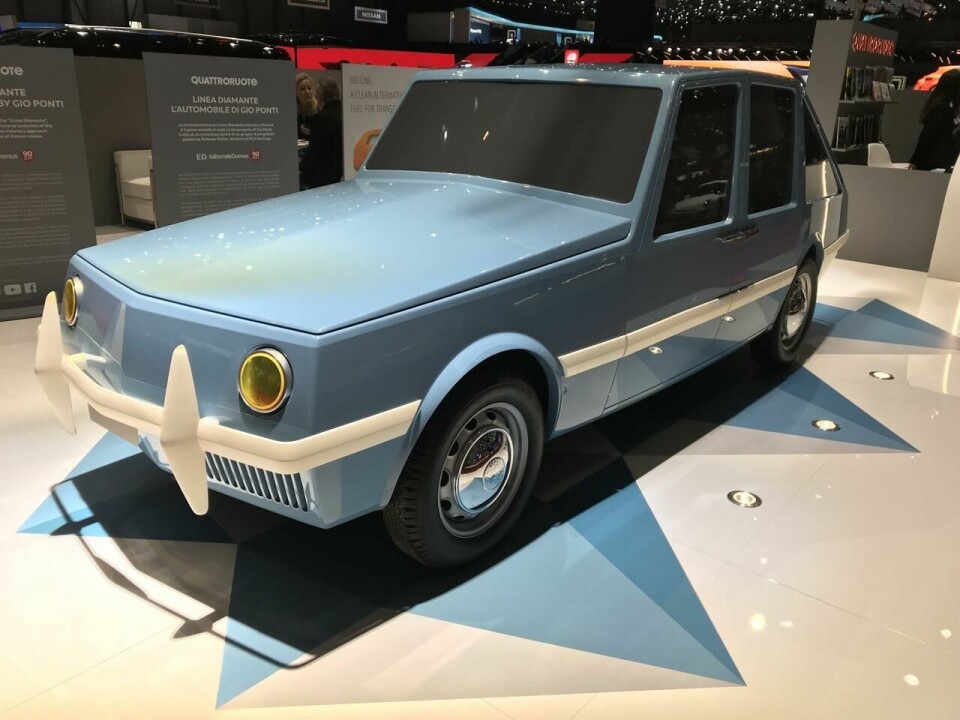
Concept Car of the Week: Linea Diamante (1953)
Arguably Italy’s greatest modernist architect, Gio Ponti also had a whirl at car design with the Linea Diamante
We saw our fair share of concepts this week at the 2019 Geneva Motor Show, but few more unusual than this full-scale model that was gracing the Quattroruote stand. The car’s name is the Linea Diamante, roughly translated from the Italian as the Diamond-shaped Line. It was designed by Italian architect Gio Ponti in 1953.
Gio Ponti was an architect, industrial designer, graphic designer, and was the founding editor of Domus, where he served for decades. Even a partial of his list of accomplishments can make any one of us feel like an underachiever.
He designed buildings in 13 countries. He wrote over 600 articles for Domus magazine, as well as other publications. He directed a porcelain manufacturer and helped revolutionise production and marketing of Italian porcelain products. He designed interiors for Italian cruise ships and specialised in ingeniously organised cabins of astonishing style and comfort. He designed all manner of products from bathroom fixtures to dining table place settings, as well as furniture and lighting fixtures.
And yes, Ponti was interested in automobiles. He looked around at the automotive landscape of the 1950s and judged most vehicle offerings to be bloated pachyderms.
He wrote that cars of the day were characterised by “useless bulk, with absurd empty spaces on the interior.” Surely, he reasoned, there would be a way to increase lightness and strength using modern structural engineering techniques.
He began to work with his associate Alberto Rosselli on a revolutionary design, based on the chassis of an Alfa Romeo 1900. The new car would be made of a lightweight frame, stiff, straight panels instead of curved ones, and a huge glasshouse to allow driver and passengers to see out of the car on all sides.
The hood was lowered, while engine and radiator venting was handled with a grille below the bumper. The bumper itself, designed in conjunction with Pirelli, was made of thick rubber and ran all the way around the car. At the front and rear, the bumper was mounted on springs to help absorb impacts.
The slope of the hood was calibrated by sight lines placed by Ponti and Rosselli at the driver’s seat. The interior had an open plan, with a large glasshouse and passenger compartment open to the storage area, just like a modern hatchback. Rear seats moved and reclined for passenger comfort.
Ponti approached Carrozzeria Touring with the idea. Touring had initially been open to developing the project, but seeing how it was progressing, decided to back away. Ponti then approached FIAT, who decided it was too radical and geometric. It probably didn’t help that the car was planned for an Alfa Romeo chassis.
It was indeed geometric and forward thinking, and automotive design would not catch up until the 1960s and ‘70s.
Without additional funding there was no way for the car to go forward, so the project was put away and soon remembered by only close associates. But the Linea Diamante project soon brought in a bigger prize: The chance to design the new Pirelli headquarters in central Milan.
Other innovative residential projects would have his attention too: the Villa Planchart in Caracas, Venezuela, the Villa Namazee in Tehran and others. He focused his ‘superleggera’ interests on the dining room chair and produced a dining room chair for Cassina that weighed only 1.7 kilogrammes.
It was Professor Paolo Tumminelli who initiated “The Automobile by Ponti” project. The project was a collaboration between FCA, Pirelli and Domus. Roberto Giolito, director of FCA Heritage, was the lead on the design team that consulted Ponti’s drawings and specifications, and translated them into full scale. The tyres, specific to the period, were the Pirelli contribution to the model.

For its part, Domus was happy to resurrect Ponti’s long-lost car, at least in model form: “When we were approached with an idea of constructing Gio Ponti’s visionary car, we enthusiastically endorsed the project. The collaboration links perfectly to Domus, now 90 years young and founded by Gio Ponti in 1928,” says Maria Giovanna Mazzocchi, President of Editoriale Domus.
The finished model was first shown at the 2018 Gran Basel exhibition in Switzerland, 65 years after its design. It made another appearance at this year’s Geneva show, where we got to inspect closely.
As for Ponti’s personal dream car, it was Flaminio Bertoni’s Citroën DS which became Ponti’s automotive love. He and each of his associates, including Alberto Rosselli, bought one in 1957, and drove them for many years.
The voluptuous DS is not exactly the straight-edged Linea Diamonte, but Bertoni’s goddess certainly achieved some of the same goals and aspirations. Apparently, the Milanese architects were absolutely helpless as they found themselves seduced into a passionate French romance.
But then, when it comes to the DS, who among us is any different?
For another story of an architect-designed car with a similar resurrection story – this time by Giorgetto Giugiaro and Italdesign – click here for the story of Le Corbusier’s Voiture Minumum.











